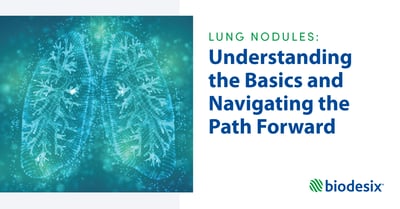How Clinics Use a Blood-Based Test to Help Identify Benign Lung Nodules [Video]
Nodify XL2™ testing is designed to help physicians identify likely benign lung nodules using a simple to use blood-based test for patients with low to moderate risk incidental lung nodules. Dr. Susan Garwood, M.D., Pulmonary and Advanced Bronchoscopy Lung Cancer Specialist with Centennial Medical Center in Nashville, part of the HCA TriStar division and Tresia Michael, LPN, Lung Nodule Coordinator for Tri-Star Health discuss how they use the Nodify XL2 test in their clinic.
View the second video, How a Blood-Based Test to Identify Benign Lung Nodules is Relieving Patient Anxiety.
Video Transcript:
Dr. Garwood: When I first heard about this test, I was super excited about it. It just made me excited and happy for the patient because I know this is going to be something that's going to be helpful to them. It's going to be helpful to the physicians who may wait too long. We want to make sure that we biopsy if they need to be biopsied or, again, give the patient peace of mind. I'm very excited about the Nodify [XL2] test because I think it's going to add an additional peace of mind and helpfulness for our clinic patients.
Tresia: the collection process for Nodify [XL2] is very simple. You do a simple blood draw, you collect the blood, place the blood on two cartridges, leave that for two minutes, pop it shut, and then you process it off to the FedEx and it comes back in five days.
Dr. Garwood: When the Nodify XL2 results come back, I have a very candid conversation with my patients about the path forward. We discuss, if their results come back that it's likely benign, that we'll proceed with CT surveillance. This is often a breath of fresh air for patients knowing that they can rest assured surveillance is the appropriate step. On the corollary, if they have an indeterminate, it also tells me that I need to move forward with my best clinical decision. This gives my patients added confidence that I've used everything at my disposal in order to make that crucial decision about moving forward with an invasive biopsy.
Tresia: When I described the Nodify [XL2] test to the patients, they are very excited to have another option, [00:12:00] so the results take five days to get back after you've had a quick blood draw and just fill two little cards and send it off and it's very simple.
Dr. Garwood: I think they enjoy the ease of the procedure. It's not something they have to go to an outside facility to have done. It's something they don't have to worry about insurance coverage. It's something that we can easily explain in an office setting that also doesn't disrupt the flow of our clinic.
Dr. Garwood: Using the Nodify XL2 moving forward is going to be a highly effective way for me to triage my patients. As the number of incidental nodules grow and as the acceptance of CT lung screening continues to grow, the number of nodules that we're going to have is going to be overwhelming. We're going to need a way to adequately triage them. This is going to help me competently move those patients forward to procedures that need to. And as we know, there's only so many proceduralists that are in the country. If we're going to ask them to do procedures, we want to make sure, number one, that it's the right patient. So this, I think, will adequately answer that need and that question on who is the right a person to go to procedure. I really think it will improve my efficiency, especially in my procedure days, but more than that, it's going to allow me to have a clinic that's more robust with information to give them so I can make that key decision.
Topics: lung nodule, video



